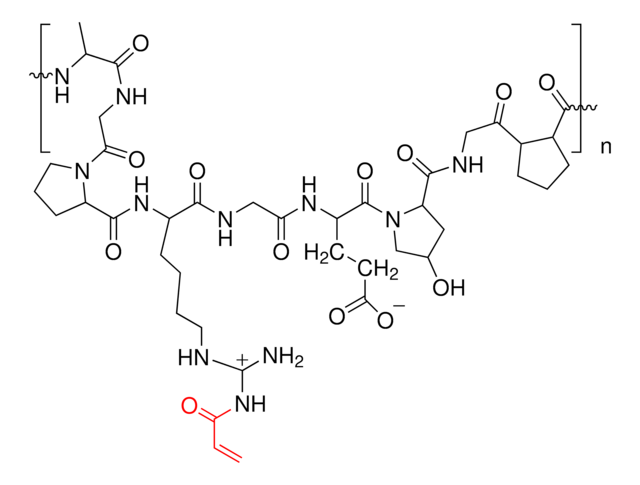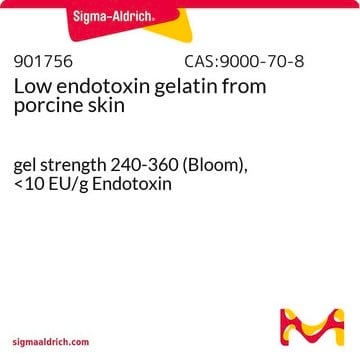900622
Gelatin methacryloyl
gel strength 300 g Bloom, degree of substitution 60%
Synonym(s):
GelMA, Gelatin methacrylamide, Gelatin methacrylate, GelMa, Gelatin Methacrylate
Sign Into View Organizational & Contract Pricing
All Photos(2)
About This Item
Linear Formula:
(C40H59N11O13)n
UNSPSC Code:
12352202
NACRES:
NA.23
Recommended Products
Looking for similar products? Visit Product Comparison Guide
Application
Gelatin methacryloyl can be used to form cross-linked hydrogels for tissue engineering and 3D printing. It has been used for endothelial cell morphogenesis, cardiomyocytes, epidermal tissue, injectable tissue constructs, bone differentiation, and cartilage regeneration. Gelatin methacryloyl has been explored in drug delivery applications in the form of microspheres and hydrogels.
Storage Class Code
11 - Combustible Solids
WGK
WGK 3
Flash Point(F)
Not applicable
Flash Point(C)
Not applicable
Certificates of Analysis (COA)
Search for Certificates of Analysis (COA) by entering the products Lot/Batch Number. Lot and Batch Numbers can be found on a product’s label following the words ‘Lot’ or ‘Batch’.
Already Own This Product?
Find documentation for the products that you have recently purchased in the Document Library.
Customers Also Viewed
Xin Zhao et al.
Advanced healthcare materials, 5(1), 108-118 (2015-04-17)
Natural hydrogels are promising scaffolds to engineer epidermis. Currently, natural hydrogels used to support epidermal regeneration are mainly collagen- or gelatin-based, which mimic the natural dermal extracellular matrix but often suffer from insufficient and uncontrollable mechanical and degradation properties. In
Jason W Nichol et al.
Biomaterials, 31(21), 5536-5544 (2010-04-27)
The cellular microenvironment plays an integral role in improving the function of microengineered tissues. Control of the microarchitecture in engineered tissues can be achieved through photopatterning of cell-laden hydrogels. However, despite high pattern fidelity of photopolymerizable hydrogels, many such materials
Kristel W M Boere et al.
Acta biomaterialia, 10(6), 2602-2611 (2014-03-05)
Hydrogels can provide a suitable environment for tissue formation by embedded cells, which makes them suitable for applications in regenerative medicine. However, hydrogels possess only limited mechanical strength, and must therefore be reinforced for applications in load-bearing conditions. In most
Preparation and characterization of gelatin-poly(methacrylic acid) interpenetrating polymeric network hydrogels as a pH-sensitive delivery system for glipizide.
Gupta NV, et al.
Indian Journal of Pharmaceutical Sciences, 69(1), 64-68 (2007)
Anh H Nguyen et al.
Acta biomaterialia, 13, 101-110 (2014-12-03)
Gelatin has been commonly used as a delivery vehicle for various biomolecules for tissue engineering and regenerative medicine applications due to its simple fabrication methods, inherent electrostatic binding properties, and proteolytic degradability. Compared to traditional chemical cross-linking methods, such as
Our team of scientists has experience in all areas of research including Life Science, Material Science, Chemical Synthesis, Chromatography, Analytical and many others.
Contact Technical Service










